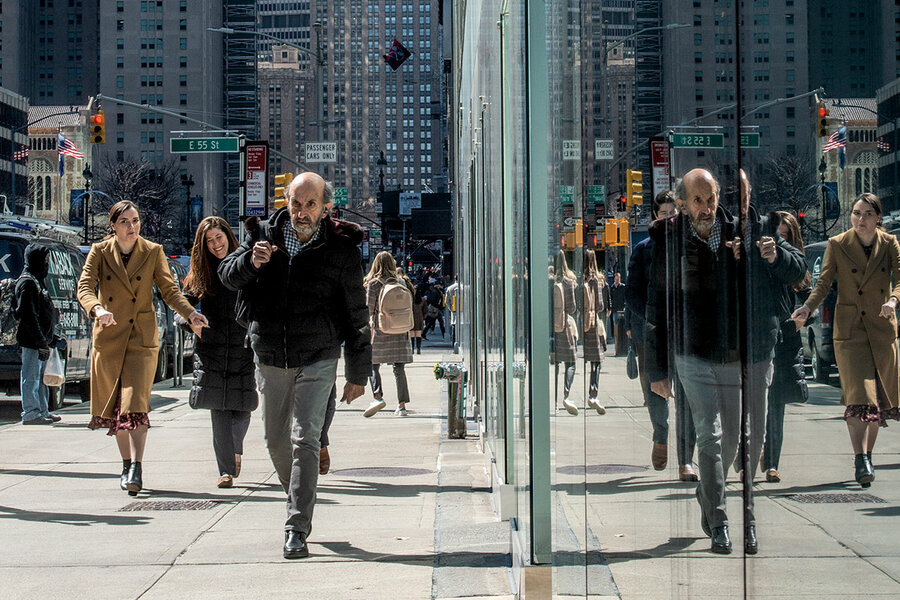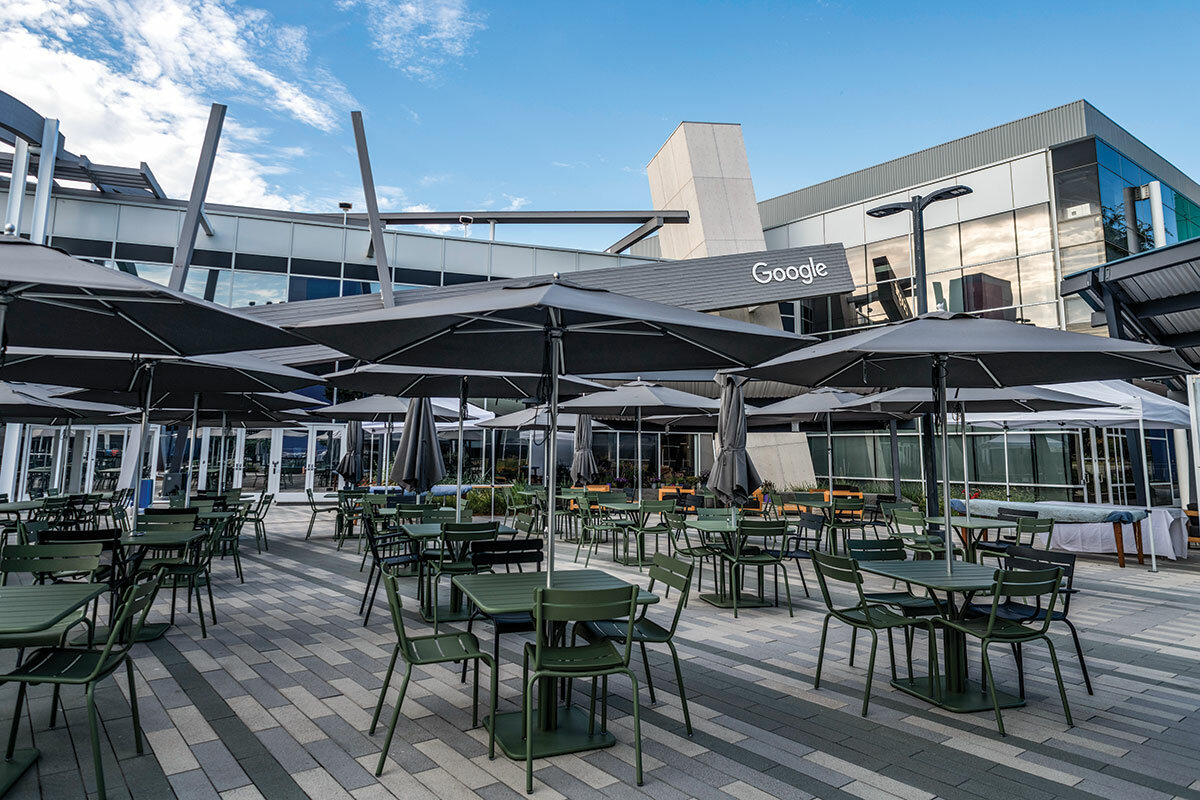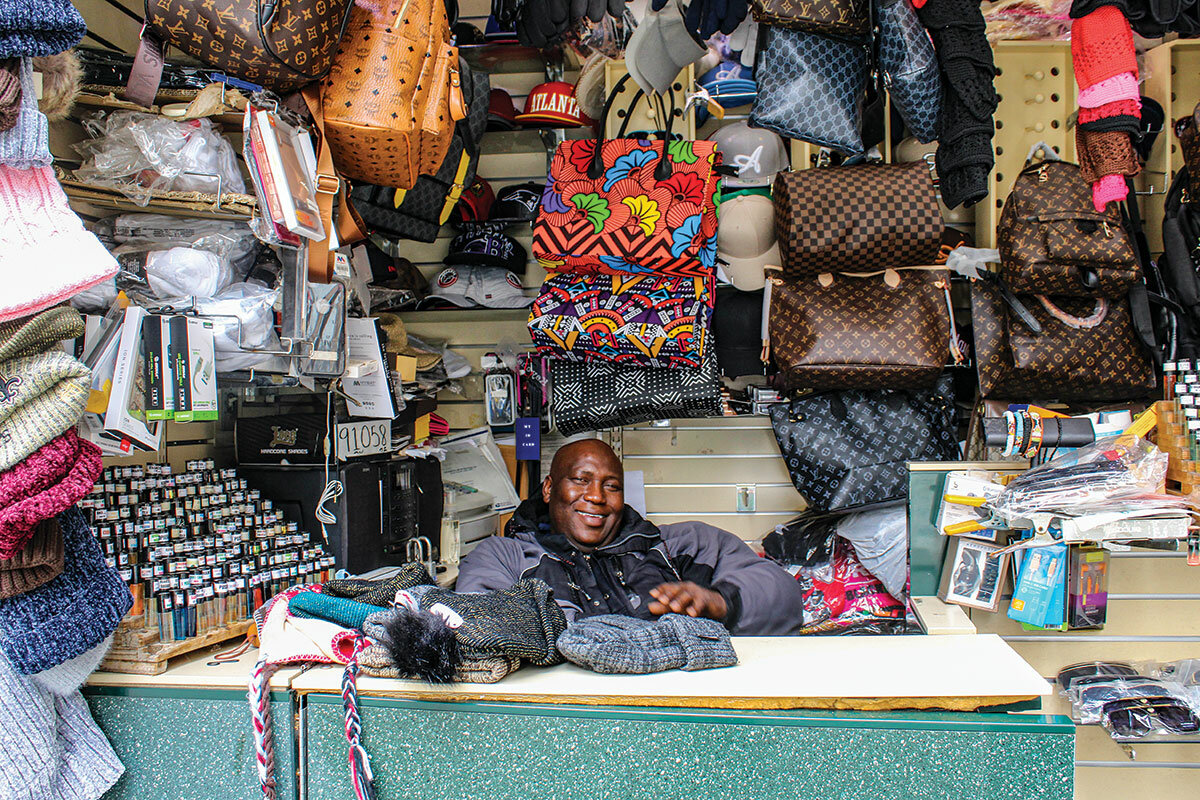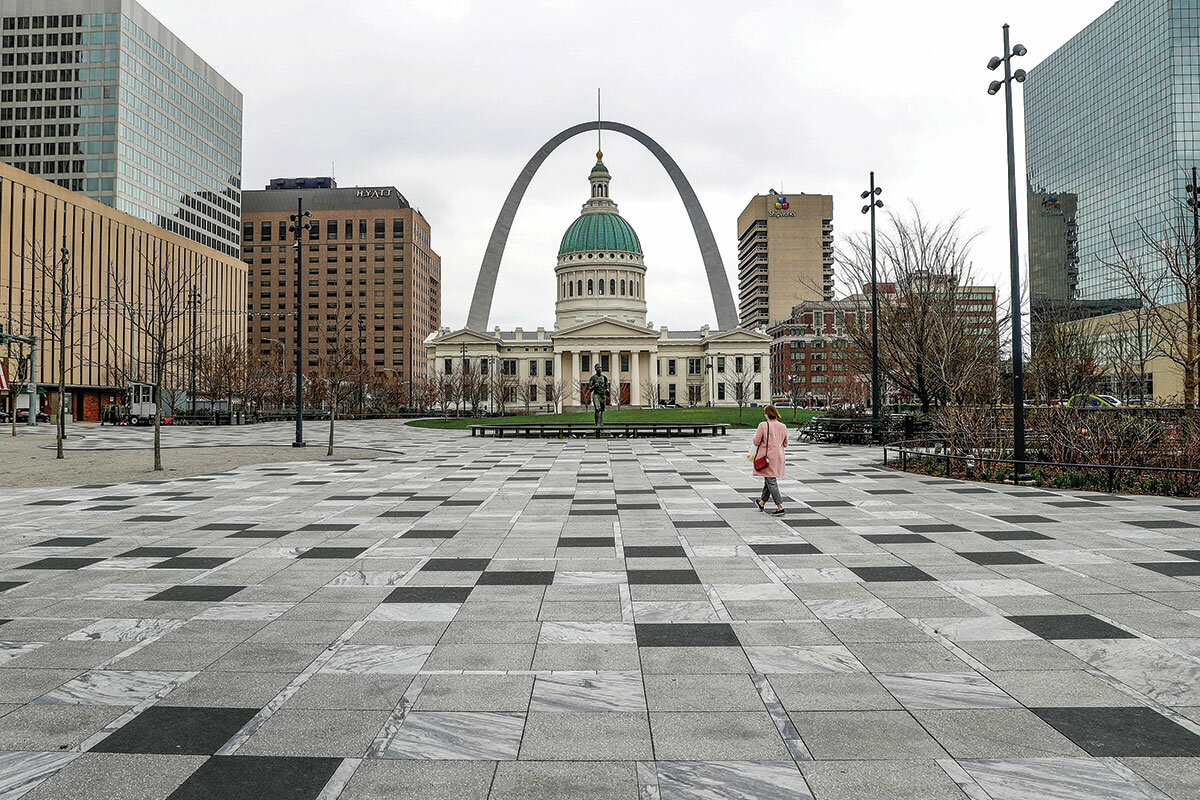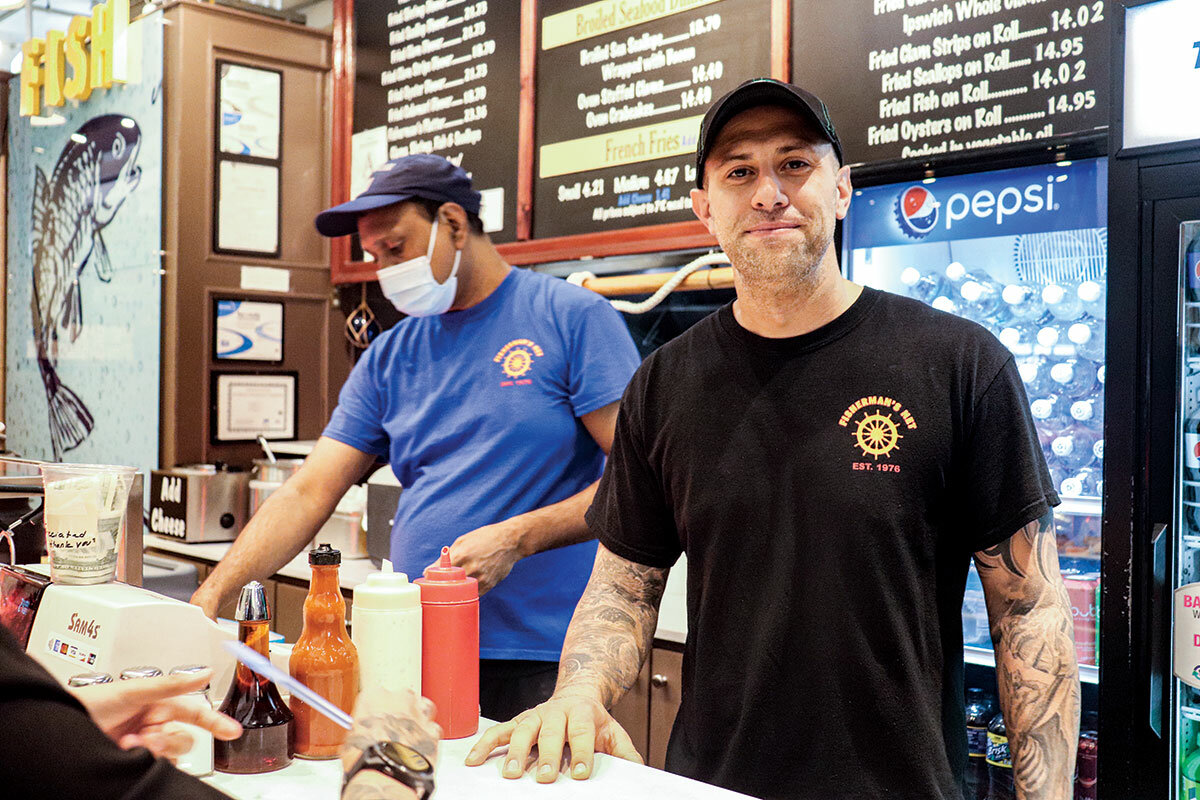Post-pandemic city: What does ‘downtown’ mean in a world of hybrid work?
Loading...
| New York, Atlanta, St. Louis, and Boston
Jordan Cohen never thought he could really feel at home outside Manhattan. “The city is just very viscerally in my DNA,” says the marketing executive. His family first settled in New York over a century ago, when his grandparents arrived at Ellis Island.
Then the pandemic hit and, almost to their surprise, he and his wife both found they could do their jobs quite seamlessly from home. So they decided to move to Maine, and within a few months had bought an old Dutch colonial. "We don’t plan on returning to NYC or city life again,” he says.
Why We Wrote This
What defines the heart of a city? For more than a century, urban communities prized and prioritized downtown business districts. The rise of work-from-home culture during the pandemic is forcing a rethink.
From the “Great Resignation” to the “Zoom Revolution” to the nationwide housing boom, the legacies of the pandemic are in many ways helping to redefine the meaning of urban life. In most major American cities, fewer than half of office workers are returning to their desks each day. For cities, this means empty offices, shuttered storefronts, cash-strapped subways, and lost tax revenues that are forcing officials to cut services.
Our reporting team visits four U.S. cities – New York, Atlanta, St. Louis, and Boston – where dramatic shifts in commuter traffic are prompting city leaders to reconsider what downtown should be.
Before the pandemic, Jordan Cohen always thought it would be difficult to leave Manhattan for good.
His work as a marketing executive in technology required the city’s concentration of business talent and the intensity of its famously frenetic business culture.
And as a born-and-raised Manhattan kid, Mr. Cohen says, “the city is just very viscerally in my DNA.” His great-grandparents arrived at Ellis Island over a century ago, and like them and his parents, he grew up in a cramped downtown apartment, coming of age during one of the city’s “mean streets” eras. He took graffiti-covered subways to his high school in the Bronx.
Why We Wrote This
What defines the heart of a city? For more than a century, urban communities prized and prioritized downtown business districts. The rise of work-from-home culture during the pandemic is forcing a rethink.
He did leave New York for college, and spent a year working in San Francisco. “But the West Coast just didn’t jibe with my East-Coast-city-kid personality,” he says. So he moved back home, found a 300-square-foot studio, and devoted himself to his career, witnessing New York’s transformation into a global tech hub and one of the safest big cities in the world.
He changed with it, too, working his way to an executive suite, getting married, and moving to a high-rise apartment with a city view. Still, over the years, both he and his wife, Elisabeth, a sales executive for a global technology firm, found that their city-that-never-sleeps lifestyles were starting to weigh on them.
Then the pandemic hit and, almost to their surprise, they found they could do their jobs quite seamlessly from home. So they decided to move to Maine, and within a few months had bought an old Dutch colonial in the salt-scented harbor town of Camden.
“I mean, this is the first time, at age 40 – this was the first time I ever lived in a house,” says Mr. Cohen, who left his job in Manhattan and started his own marketing company, The Fox Hill Group, from a home office with mountain views. “Who knows what the future holds, but we don’t plan on returning to NYC or city life again.”
From the “Great Resignation” to the “Zoom Revolution” to the nationwide housing boom, the legacies of the pandemic are in many ways helping to redefine the meaning of urban life. The ability to work remotely has begun to change the geographies, if not the sensibilities, of millions of lives and careers, especially in America’s major cities.
Five million people have already moved during the pandemic, and according to economic surveys, an estimated 14 million to 23 million more Americans are saying they are likely to move as well as they become unmoored from their offices, especially those in urban business districts.
“Today’s COVID-precipitated crises may well prove to be the most transformative event that America has experienced since the great migration to the suburbs after World War II,” says Richard Florida, a leading urban thinker.
In most major American cities, fewer than half of office workers are returning to their desks each day, including those with hybrid schedules. Only 36% of office workers in the New York metro area were back at their desks at the start of April, according to Kastle Systems, which measures keycard swipes in buildings it serves in 10 major cities.
For cities, this is a problem. Empty offices bring a series of cascading effects. Storefronts shutter, already cash-strapped transportation systems lose revenue, and tax bases shrink, forcing officials to cut services.
In New York, subways and buses were carrying only 60% of their pre-pandemic riders at the start of April. Restaurant reservations remain 40% below pre-pandemic norms. And the city has lost up to a third of its small businesses for good, experts say, which helps explain why its unemployment rate continues to hover above 7% – double the national average.
With tough times and urban ennui come disorder. Indeed, crime has skyrocketed in New York and many cities across the nation over the course of the two-year pandemic, compounding the challenge of luring back
office-shy workers.
Local leaders have urged workers to return, sometimes with notes of irritation and sarcasm.
“You can’t tell me you’re afraid of COVID on Monday and I see you in a nightclub on Sunday,” Mayor Eric Adams said earlier this year. “That accountant that’s not in his office space is not going to the cleaners, is not going to the restaurant, is not allowing the cooks, the waiters, the dishwashers [to return to work]. It’s time to open our state and our city and show the country the resiliency of who we are.”
But even some of these workers aren’t anxious to return to their former grind. Meyin Chan, an immigrant from Ecuador who lives in the Bronx, used to take the subway more than an hour each way to her job at a hotel in Times Square, where she managed a staff of eight handling reservations. A week after the city shut down, the hotel dismissed most of its staff.
The past two years have been especially difficult for the mother of two. Even if her old job were to return, she’s not certain what she would do.
“You know, I don’t want to go to Manhattan anymore,” she says. “Maybe because I’m too old to commute that long. ... I mean, something happened with me.”
Still, even if the pandemic is disrupting lives and livelihoods, it is also spurring cities to search for ways to reinvent themselves, just as many did decades ago when factories closed or moved overseas.
“I kind of think we misthought central business districts as simply arenas for office work,” says Dr. Florida, who is a professor at the University of Toronto’s School of Cities. With their sterile concentrations of skyscrapers, dearth of residences, and lack of activity at night, they are in many ways “the last remaining holdover of the Industrial Revolution,” he says.
Most cities have been designed around business districts and the office workers that commute in each day. Roads and public transportation systems have catered to these in-and-out flows. An economic ecosystem of shops and restaurants grew up to serve the commuters.
Urban planners have thought about this for years. Many now envision what they call a “15-minute city” in which every resident would be within a 15-minute walk or bike ride from anything they need, including parks and open spaces.
Central business districts need to be re-imagined as more of an “essential lifestyle district” or a “central culture district,” says Sofia Song, global cities lead for Gensler, an architecture and design firm. “It would be designed to be something that is much more connected, much more diverse, and which would make it a lot more resilient,” Ms. Song says.
Indeed, as the work-from-home trend takes hold, not everyone is looking for a rural idyll or suburban house with a yard. Millions still prefer an urban lifestyle – but in more livable cities, Gensler surveys find. Urbanites want shorter commutes, and access to more green space, as well as safe, affordable places to live.
A number of cities are already sketching plans and making changes for a post-pandemic reality. And one common theme is that traditional office districts may no longer be as central to their downtown cores.
ATLANTA – Abdul Seck has always had a straight-shot view of Atlanta’s Broad Street and its gentle rise up to the city’s downtown district on Peachtree Street.
A purveyor of fine handbags and scented oils at his kiosk here for 20 years, Mr. Seck, whose slightly brooding demeanor gives way to an easy smile, has watched the pulse of Atlanta’s city center ebb and flow as it followed the rhythms of the local economy.
But the past two years have been unusual as Atlanta, like many other major American cities, has seen its central business districts hollow out. Car trips downtown are still down 16% since before the pandemic. Streetcars run past his stall, but remain mostly empty.
Foot traffic, the lifeblood of his business, has also dissipated. Far fewer office workers, tourists, and local Georgians now fill the city’s streets. Boarded-up storefronts tell the tale of the pandemic’s downtown economic toll. Even the nearby McDonald’s and Burger King are gone. “There’s no money. Things are tough,” he says.
It’s a familiar refrain: Office vacancies, already a problem in 2018 when the city was wrestling with 4.8 million square feet of empty office space, jumped to nearly 11 million in the first three months of 2022 – about 15% of Atlanta’s office space total, according to a CoStar Analytics report.
Yet for all the lack of pedestrian traffic now, Mr. Seck can hear the bulldozers around the corner in an area known as “The Gulch” – a vast former rail yard, bracketed by aging viaducts, that is being converted into a mixed-use space of parks, housing, and retail.
City planners and developers see the pandemic-induced malaise here, as well as in much of urban America, as an opportunity not only to transform downtown districts, but also to introduce new values. Instead of viewing an urban center as simply a concentration of office buildings, they want to put more emphasis on a city’s history and identity – a place where people work, yes, but also live and connect with each other.
Developers in Atlanta have already begun to re-imagine downtown. Condos are going to be added to the signature Peachtree Center office tower. The project at The Gulch includes retrofitting the railroad’s former headquarters into a complex of mixed-income apartments and public parks called Centennial Yards.
Around the corner from Mr. Seck’s stall, developers are starting to rehabilitate an area known as Hotel Row. One abandoned tower is slated to become an apartment complex, which will include 300-square-foot studios – an effort to make housing affordable and bring economic diversity to the area.
“There are competing zeitgeists right now,” says Gene Kansas, who runs a commercial real estate firm. “On one hand, you have the globalization or the Las Vegas-ization of this country. The other is to, ‘just make it real, please. Make it genuine.’ There are a lot of people in Atlanta right now who realize the value of the preservation of history and that people want that.”
Adam Crawford, an Atlanta native, has watched the emerging changes through his picture windows at Cat Eye Creative, an art gallery on Mitchell Street that he opened in January 2021 inside a former drug store.
“Some people gave up” after the pandemic hollowed out Atlanta’s downtown, he says. “Others capitalized.”
As developers seek to repurpose some of the city’s historic buildings, local preservationist David Mitchell sees the post-pandemic future of Atlanta’s downtown district as “our moment.”
“Everything in Atlanta is a story. ... So you have to embrace a certain level of Atlanta identity and culture,” says Mr. Mitchell, the executive director of the Atlanta Preservation Center.
Longtime resident June Moore is concerned that the identity of the city will change as newcomers arrive. She takes a bus nearly every day downtown, whether to shop, do errands, or socialize.
She complains that the city’s transportation system has become erratic, given its lingering staffing problems and dwindling ridership. But she also acknowledges that part of the charm of downtown Atlanta is its ability to be a canvas for newcomers to paint new lives.
“Atlanta is what you make of it,” she says. “That may be even more true after the pandemic.”
ST. LOUIS – Veronica Holden, co-owner of La Mancha Coffeehouse in a northern neighborhood of St. Louis, doesn’t feel good about the pandemic’s effect on her city, for very personal reasons. She’s mixing a drink behind the counter on a Wednesday afternoon – the day before her business is set to shut down permanently.
A lone customer sits at a table in what was once a thriving local haunt, an intimate space that featured artwork by local painters and offered a place for people to mingle, espressos in hand.
“St. Louis has been rocked by a lot of different things,” says Ms. Holden, recalling the shooting of Michael Brown in Ferguson, Missouri, in 2014. But “we had always been able to kind of bounce back.”
About a mile and a half outside St. Louis’ downtown business district, this neighborhood shop is part of the post-pandemic funk many city centers are now facing. Compared with other cities, St. Louis has long had one of the least populated downtown areas, and the pandemic means even fewer people milling around at night and spending money in shops and restaurants.
So a significant part of the downtown economy has focused on tourism and business conventions, leveraging the city’s iconic Gateway Arch. This area alone has received around $380 million in new investments over the past decade, according to Brian Hall, chief marketing officer for Explore St. Louis, which promotes the city as a convention, meeting, and leisure destination.
“Event activity coming into St. Louis has just been enormously important in the recovery of tourism in the downtown core,” he says.
Still, Mr. Hall believes that cities, including St. Louis, need to revitalize their downtown areas by encouraging more residential living, buttressed by a vibrant entertainment culture. They should become a magnet for innovators and entrepreneurs, he says, who want to be in the urban core for the “collision of creativity and ideas.”
Like other cities, St. Louis has tried to find ways to repurpose its past, in its case as a manufacturing hub on the banks of the Mississippi River. Old warehouses and factories have been converted into office spaces, artist studios, and entertainment venues.
“Downtowns are always having to change, as it turns out,” says Robert Lewis, professor of urban planning and development at St. Louis University. “And if we build structures that cater only to a fairly narrow part of the economy – well, they become obsolete.”
Yet St. Louis is competing with cities such as Atlanta; Nashville, Tennessee; and Austin, Texas, which are all trying to do the same thing: attract new business investment and build downtown cultural and entertainment venues, as well as parks and open spaces, that will lure visitors and residents.
Visitors are already returning to the Missouri Botanical Garden, considered one of the nation’s top gardens, says Catherine Martin, the garden’s public information officer. She puts visitor numbers at close to pre-pandemic levels. But while the garden’s finances were cushioned by tax and donor revenues, private businesses located downtown have been hit hard by the pandemic.
“There will certainly be a good number of organizations, corporations, and other businesses that continue to conduct business in urban cores, including St. Louis,” says Mr. Hall. “But everything that was in place prior to the pandemic can’t simply resume as it was. Some businesses are going to need to look at their positioning, their reason for being, and then determine if there is still an opportunity for them to return.”
Shannon Brantley, manager at Band Box Cleaners, says business has recently picked up as conventions start to return to St. Louis. But it’s still not the same.
“When we came back to work [in 2020], our business dropped 90%, because you figure all the restaurants were closed, all the courts were closed, all the businesses,” says Ms. Brantley. “So no suits, no banquets, no concerts, no nothing.”
While the family that owns the business closed one of its dry cleaning stores during the pandemic, she hopes to keep this one open. “We’re going to be here until there’s just no more money for us to, you know, keep the lights on or pay the employees.”
BOSTON – George Maherakis has been serving Ipswich clams and homemade chowder in Boston’s historic Quincy Market for more than 23 years.
His seafood stall, Fisherman’s Net, is steeped in both family and Boston history. His father opened the business here in 1981, under the Greek Revival dome that has been a part of the marketplace since 1826.
Fisherman’s Net has survived the pandemic, even as numerous commercial stalls around him have remained empty. At the low point in 2020, visitor traffic at Quincy Market was down by 95%.
Business has picked up lately with the return of tourists to Boston, but a significant part of Mr. Maherakis’ longtime customer base is still missing.
“I’m definitely worried about it because we need the office workers to come here and work,” says Mr. Maherakis, who is president of the Faneuil Hall Marketplace Merchants’ Association. “We need them to fill up the city again.”
Yet even though Boston has seen the cascading effects of the work-from-home revolution on downtown businesses, experts say the city is better poised than others to recover from the pandemic’s economic hit.
Boston currently has one of the lowest office vacancy rates in the nation. One reason is a biotechnology boom that supports both demand for existing office space and, increasingly, the conversion of office buildings into laboratories. Since 2016, nearly 3.5 million square feet of office space has been converted to laboratories in the Boston area, according to the Boston Business Journal. Another 8.5 million more square feet of office-to-lab conversions are on the way.
Even so, new hybrid models of work mean fewer daily commutes into Boston’s business districts. Already the changes can be seen in the foot-traffic patterns monitored by the Downtown Boston Business Improvement District. Using 14 motion sensors, the group has calculated that in one week just before the pandemic hit in March 2020, there were more than 850,000 people walking around the city’s downtown districts. During the same week in 2021, the number dropped to 195,000. More recently, the number of pedestrians rebounded to 465,000 – still well short of pre-pandemic levels.
While much of this is due to the lingering at-home workforce, some of it has to do with changes by businesses themselves. Many firms with flexible working models are remodeling offices to spread out desks and add more spaces where workers can relax, a departure from the cramped cubicles of yesteryear. The net result may be offices with fewer workers on any given day.
“I think that has pros and cons, and our ability – our survival – will be how we adapt to that,” says Anita Lauricella, interim director of the Downtown Boston Business Improvement District. For now, her agency is trying to coax more local visitors to the area after-hours and on weekends by promoting public events such as ice sculpture displays.
Yet the people who live and work downtown are still vital. Just ask Al Costello, owner of Al’s State Street Cafe, a popular sandwich shop not far from Quincy Market. Eight out of 10 of his customers come from the high-rise office towers that surround the shop on a narrow street in Boston’s financial district.
“I mean, these streets, you could barely fit on the sidewalk,” says Mr. Costello, recalling the pre-pandemic lunch crush. “It looked like Wall Street at 12 in the afternoon.”
Revenues at this cafe, one of four he owns in the Boston area, are back to 75% of pre-pandemic levels, he says, but not because all the bankers and traders have returned. The real reason is that many of his competitors closed down, so he gets what trade remains.
The city of Boston has tried to mitigate the pandemic’s impact on local businesses. But there’s also new thinking about urban planning around downtown business districts. The administration of Mayor Michelle Wu, who took office last November, has signaled a renewed emphasis on places such as East Boston, a densely populated immigrant neighborhood across the mouth of the Charles River from downtown Boston.
“I absolutely believe that this shift is the right shift for cities,” says Tanya Hahnel, a project manager at the East Boston Community Development Corp. “I think it’s about time that they started putting money into the neighborhoods where their workers live, not just in neighborhoods where their workers work.”




